Wind-generated sea waves

Wind-generated waves occur when the wind blows over the surface of the sea. They are divided into gravity waves (wind sea, and swell) and capillary waves. Their period is usually equal to or less than 30 seconds, and their wavelength ranges from some millimeters up to 1500 meters.























